Let me ask you, do you herbally leverage your bath time with bathing herbs? If you aren’t into baths or don’t have a bath tub, just click away now… If you own a bath tub, read on to find out the healing benefits of herbal and flower baths!
If you don’t currently herbally leverage your bath tub time, STICK WITH ME a bit! (I know, I am not sure anyone has ever put this combination of words together before, herbally leverage… I kind of like how it sounds!)
This is one of those things that if you just take a little bit of time to implement, the return on your time investment is going to amaze you and you will seriously wonder why you haven’t been bathing with herbs all along.
I am telling you upfront that my intention is to inspire you to add the homemade luxury of herbal baths to your everyday life.
What Herbs and Flowers Are Good for Baths?
Ok, ‘nuff said! Let’s talk about what herbs and flowers you can put in your bath! Here are five of my favorite bathing herbs and flowers and their benefits for the body, mind, and spirit.
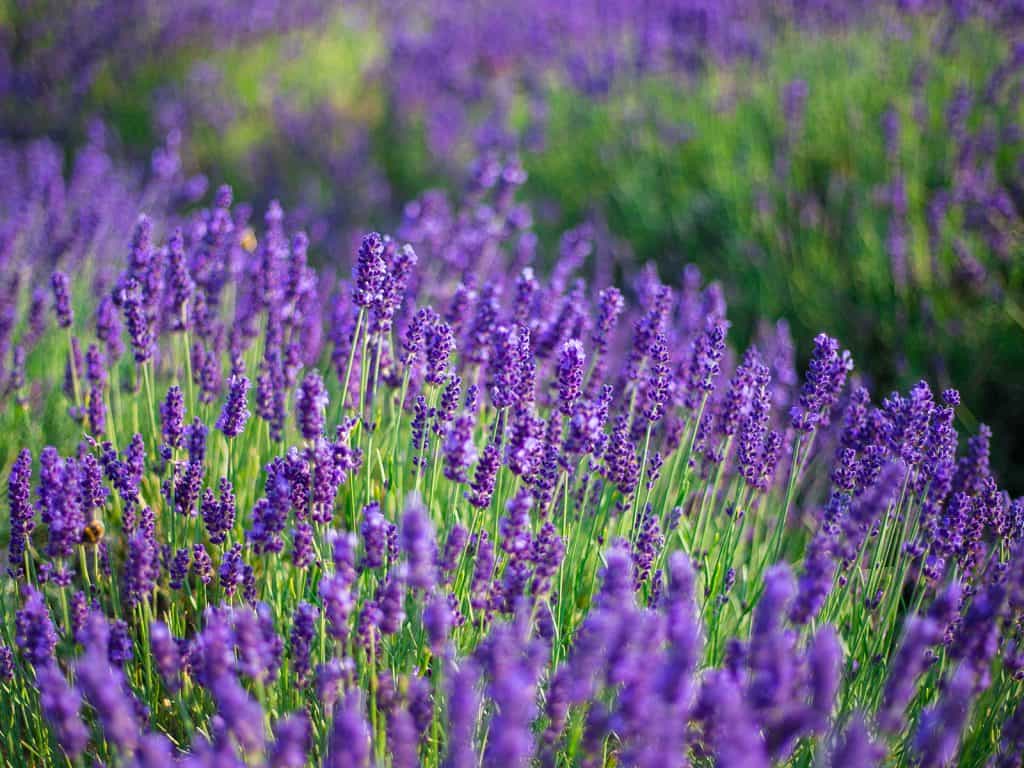
Lavender
Botanical name: Lavandula spp.
Part used: flowers and leaves
There are many kinds of lavender. I like Lavandula angustifolia the best. However, use the lavender that you have growing and like the smell of. Some lavender plants have had the aroma hybridized out of them; they are beautiful but don’t have much smell. When using fresh lavender, choose aromatic lavender for your bathing. This is not a problem with dried lavender; if someone took the time to dry it and sell it to you, it will be aromatic!
There is nothing like the pampered feeling of a revitalizing lavender flower bath. Lavender has so many therapeutic uses including being anti-bacterial, anti-fungal and anti-inflammatory. We usually turn to lavender for its relaxing herbal bath benefits, but it has many more uses!
The anti-bacterial and anti-inflammatory properties of lavender make it a first-rate healer for cuts and minor skin inflammation and infection. Lavender helps heal acne, eczema and minor burns. Think of taking a lavender bath when you have any kind of skin inflammation. It cools your skin and calms your mind. A lavender bath also serves as a refreshing tonic that can relieve headaches, muscle strain, stress, tension and general aches and pains.
As you sit in a lavender bath and breathe in the aroma, it helps to keep away congestion and colds. Lavender is true to the Latin roots of its name, lavare, which means to wash. This bathing herb washes away skin problems, colds and tension.
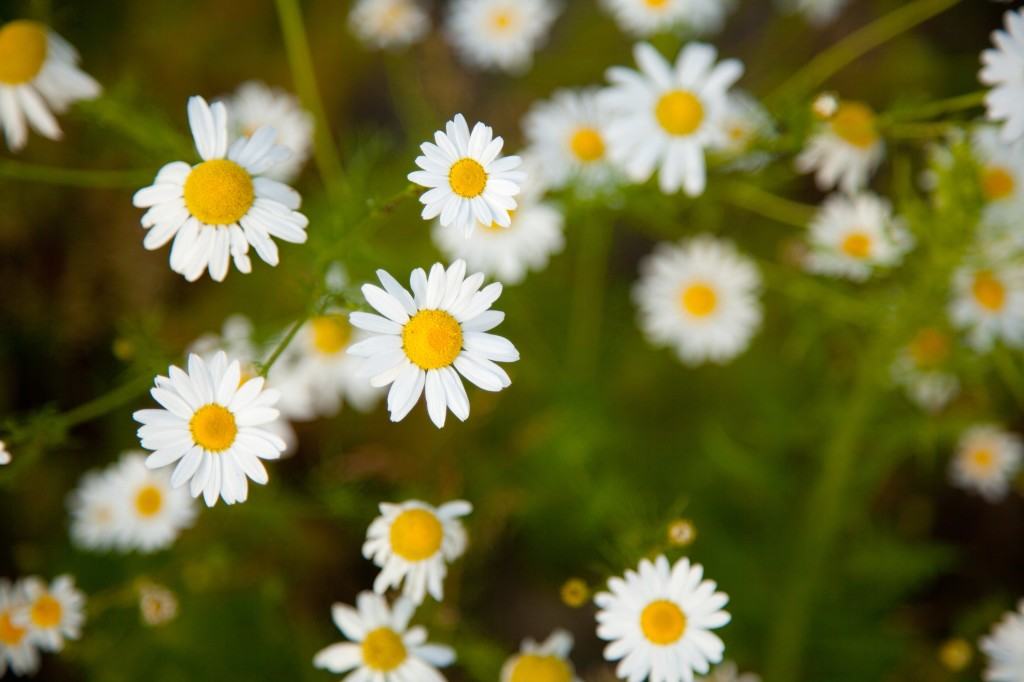
Chamomile
Botanical name: Matricaria recutita
Part used: flowering tops
Chamomile is a timeless herbal bathing remedy. It is calming, relaxing and soothing. It quiets the nervous system and is the healing remedy of choice after a physically or emotionally demanding day. Chamomile is also antispasmodic so it helps reduce muscle cramps and muscle tension.
When stress really sets in, we just become more and more used to the tightness in our muscles to the point we don’t even realize how tense we are. When I think of a chamomile flower herbal bath, I think of one of the benefits as having a “melting” effect on my muscles, they just have to relax! I rely on chamomile in my baths to help scrub away irritability and tension that is either physical or emotional.
Chamomile is also a superior skin healing herb. It helps to rejuvenate the skin and repairs damaged skin. It soothes and softens itchy skin and helps heal cuts and scratches.
Dim the lights, fill your bath with a chamomile infusion and just completely separate from your over-scheduled day. Ask for help in letting go of what you don’t need and let chamomile work its magic.
Note: Chamomile is in the ragweed family. Use with caution if you have an allergic sensitivity to plants in that family.

Calendula
Botanical name: Calendula officinalis
Part used: flowers
When calendula flowers find their way into your bath tub, they work miracles on your skin. These golden flowers are renowned for their ability to reduce redness, itching and topical inflammation. Calendula helps to soothe and repair the skin and reduces injury recovery time. If you have been working in the garden or picking blackberries and have lots of fresh little scratches (I live in blackberry country), put calendula into your bath preparation.
Calendula flower bath benefits include healing minor scrapes and scratches, and it is helpful for just about any skin irritation. It helps alleviate acute and chronic skin problems and moisturizes the skin.
Calendula is also a wonderful herb for reducing your susceptibility to a cold. This plant has strong anti-bacterial properties and helps to fight off colds and infections. These sunshine-colored petals will definitely stain your tub if you don’t clean them out after your bath!
We enjoy calendula bath benefits all year-round. These flowers are a great addition to your bath if you are trying to keep away a cold in the winter. Calendula flowers are also a good bath ingredient in the summer with benefits for healing the skin from all the cuts and scratches that a summer day of play can bring.
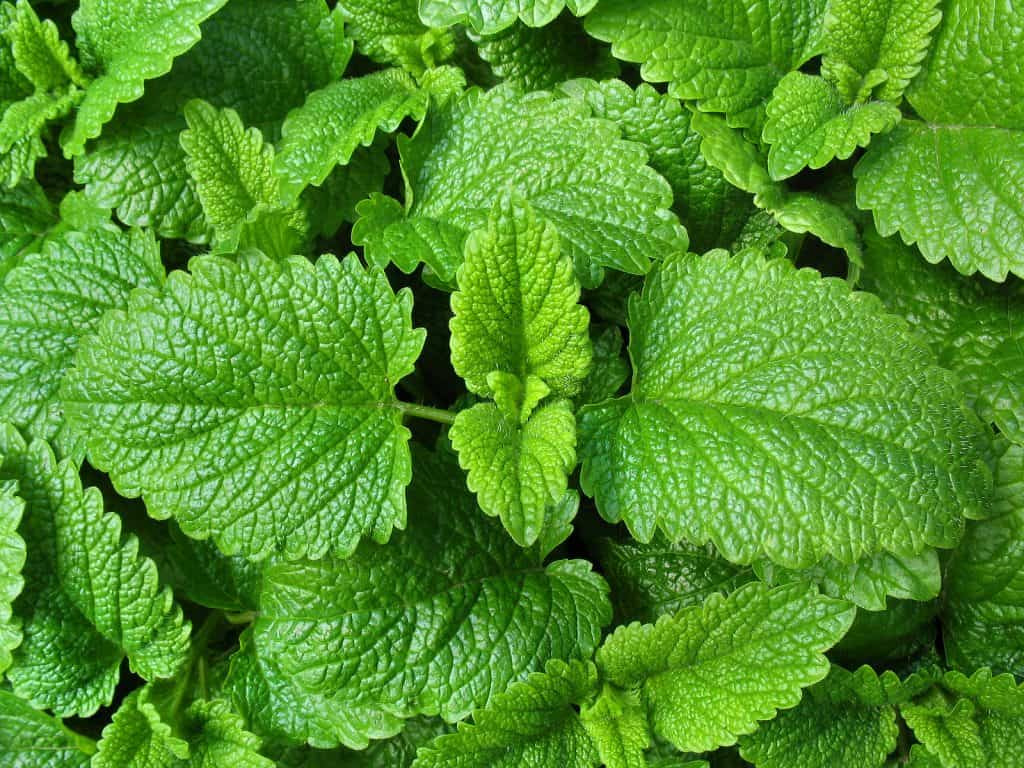
Lemon Balm
Botanical name: Melissa officinalis
Part used: leaves
Lemon balm has a sweet smelling, lemony scent and makes a superb herbal bath. Lemon balm is a cooling and restorative herb that helps to calm the nerves and enhance your mood. Lemon balm is relaxing and uplifting. It has a palliative effect on excessive mental activity and it moderates the intensity of mood swings and depression. Lemon balm has a long history of being used for restlessness, irritability and insomnia.
I think of lemon balm as an herb that “chases away melancholy.” Lemon balm is the herbal companion of choice in the face of tension, anxiety, stress-related fatigue and tension. It helps to resolve anxiety and emotional unrest and intervenes when emotional states take over your life.
Enjoy the tranquil feeling and peacefulness that enters your body with a lemon balm bath. Say a prayer to let go of what you don’t need and ask for help in gaining new perspective on your challenges.
Lemon balm is also very healing for the skin and has great herbal bath benefits for scratches, scrapes and bruises. It acts as a topical anti-histamine and works wonders on bug bites and any skin inflammation.
Children love the smell of lemon balm and it makes the perfect before bedtime bath.
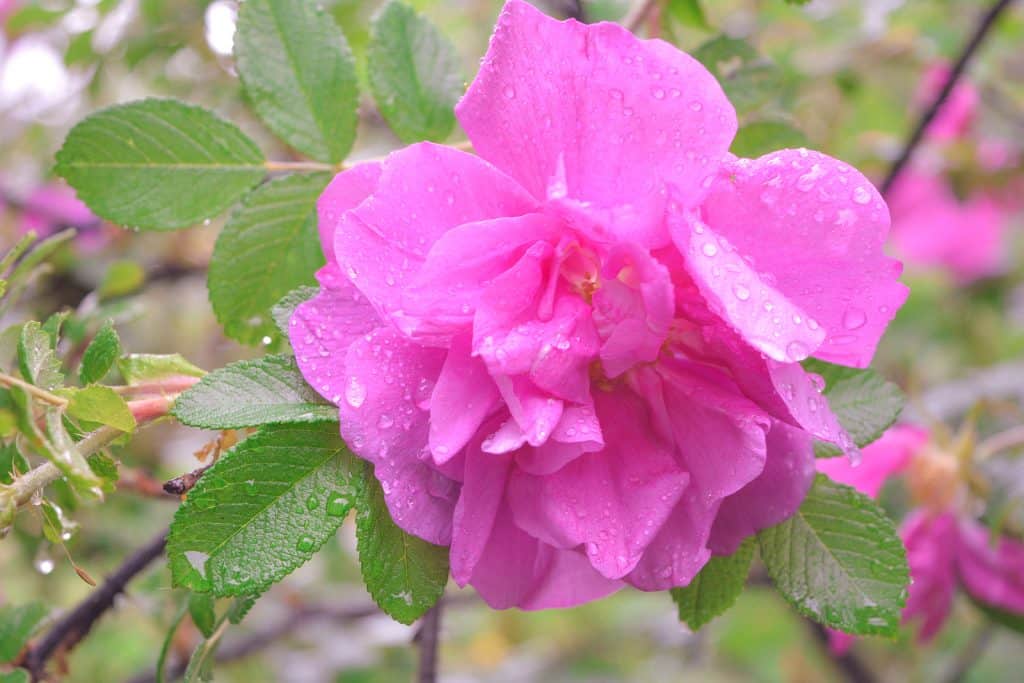
Rose
Botanical name: Rosa spp.
Part used: petals
All rose petals are medicinal! Any rose petal can be used in your bath as long as it is not sprayed with chemicals. Yes, the pink, red, purple, yellow, gold, white and orange petals from your rose bushes have lots of healing properties and make luxurious baths. I especially like to bathe with red and pink rose petals, but you can use any color or type of rose petal. I don’t recommend commercial roses because of the amount of herbicide used in their production. As always, you want your herbs to be organic and pesticide free.
Roses are known for their ability to nourish the heart and lift the spirit. They are soothing, calming and cooling and particularly restorative to the nervous system. Rose flower herbal bath benefits include calming the nerves, opening the heart and relaxing the mind.
We rely on rose petal baths during the hot summer months. Roses help to draw excessive heat from the body. They help to relieve inflammation associated with rashes, acne, insect bites and minor cuts. If your headache is caused by being overheated, a tepid rose petal bath can help you. Any time you are irritated, overworked or overheated, think of helping yourself with a soak in rose petals.
Even if I am not overheated or irritated, I enjoy steeping my body in the sheer beauty of this revitalizing, healing flower.
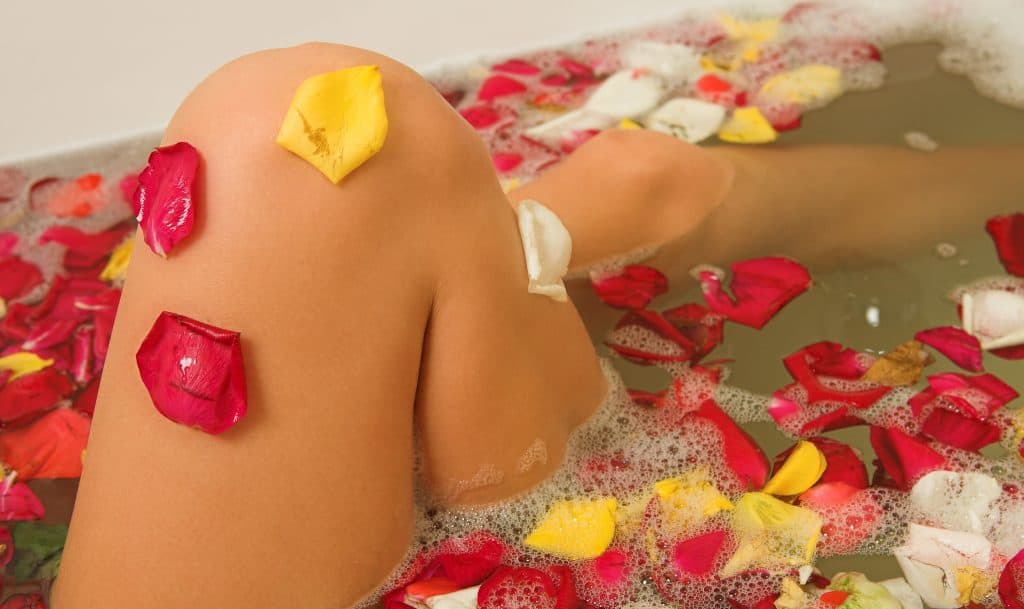
How Do You Make an Herbal or Flower Bath?
You can use one or two of these healing herbs and flowers in your bath or a variety. They can be fresh or dried.
If you’d like to use dried herbs for bathing, one of the easiest and most convenient ways is to make an Herbal Bath Tea Bag recipe. Dried herbs can be purchased from Mountain Rose Herbs and you can make a big batch of bath tea bags and keep them in a jar in your bathroom.
When using fresh herbs and flowers, I put different ones in my bath depending on the season and what I have growing in my garden. Check out my article on How to Make a Healing Garden Bath to learn more about using fresh herbs for bathing.
Benefits of Bathing Herbs for Kids
Another reason I love herbal baths so much is that it’s a great way to get your kids to buy into the whole herbal thing early on!
They can’t help but tear the fresh flowers into a thousand pieces while they are in the bath tub. They learn about the herbs this way. The texture and aroma permeate their bathing experience and they quickly learn to identify herbs by their smell.
Sometimes they need to use the shower for a few minutes afterwards to wash off all the plant bits that are stuck to their body, but hey — no big deal in the pursuit to create future herbalists!
Herbal bathing routines are a wonderful way to inspire our children to be engaged in their self-care and wellness. Over time they become more empowered in their skill of self-healing. They discover that with herbal bathing techniques, they have the ability to relax, calm themselves down, reduce the inflammation on their skin, disinfect a scratch and cool themselves off after a hot day in the sun.
Herbal bathing helps children to realize that with a little attention, they can take care of their body in very simple ways. Herbal bathing is a valuable tool that we can teach our children that will support them throughout their lives.
I would LOVE to hear about your herbal bathing escapades! What are your favorite bathing herbs? What kind of benefits have you experienced from herbal or flower baths?
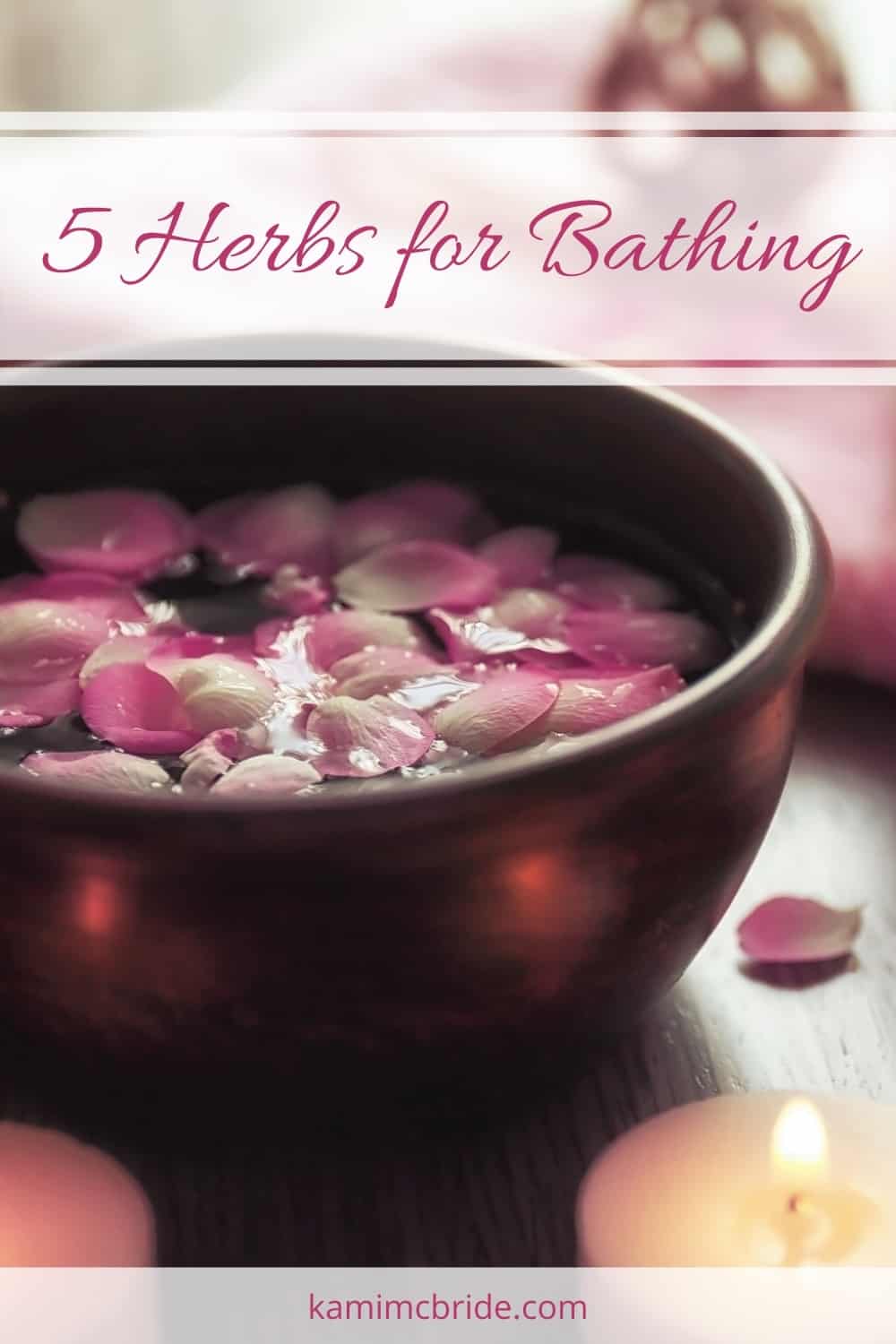



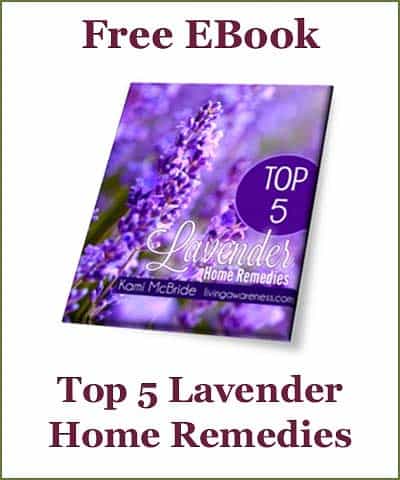

I did some herbal baths in my first 6ish weeks postpartum because I was gifted some herbal tea bags for that purpose. I found it wonderfully relaxing and healing. It didn’t occur to me to continue after that, so thanks for the inspiration! My 3 year old son would also love this.
So happy to see you are inspired to give herbal baths a go for everyday use!
So many things can be healed with a good herbal soak 💝
Great ideas, and reminder. Thanks Kami
Thank you Kami, I knew about lavender, but now I’m going to try chamomile. Love your saying, “Ask for help in letting go of what you don’t need and let chamomile work its magic”.
Kami, I love this idea. Bathing in herbs will enhance my bathing experience 100 fold. You bring the gifts of herbs to thr forefront for practical and everyday experiences, great gifts for the herbal novice and experienced alike. Can’t wait to put it into practice. I’m growing all your suggested herbs except chamomile, hoping to get that growing this year.
Enjoy!
…something I do is make the tea in a big kettle first. Bring the water with sage leaves in it just to boiling, switch it off and let is steep for about 5-10 minutes, or longer, and then pour only the tea into the tub, keeping the leaves in the kettle with the lid, much like pouring the water off of a pot of beans or pasta. The tea is a nice dark green and it makes the bath water all a light lovely green. (Sage, that is, I’ve not tried the herbs you mention.)
I have all 5 of these plants in abundance. This is super helpful info. I had been bathing in sage tea because that is another plant I have a LOT of….
I really love this idea. Thank you for sharing it. Kami, you really have explored ways to bring herbal gifts into our lives in very practical ways. You give real gifts to the herbal novice and experienced alike. I’ve used epsom salt and essential oils in baths, but herbs sound so much more beneficial and delightful to me.
You are so welcome!
I can not find these herbs around here but lavender due to the farms but the other plants forget it and no use trying to buy it dry here either and some plants I have never heard of them, good thing for information like this, thank you
Wow! What a great share! You put it all together so nicely and in easy to understand terms. I grow lots of herbs and now I know what i will surely be doing with all the extra!!! Thanks sooo much! I love these emails! Have a beautiful day!
So glad you are inspired to bring the gifts of the herbs more deeply into your life!
Kami, thanks for the tour through all the plants that lend themselves to a healing bath. I love that all of these plants are ones that I have in my garden and work with already. It would be great if you gave a little more information about how much of the plant material is needed to create a healing effect and especially how do you clean out all the petals before draining the water from the bath.
Yeah, that is the problem with fresh herb baths, they are a big mess, no getting around it! I use a washrag and just keep scooping…..
I usually put about 4 cups of fresh herbs into a garden bath. Some people experience healing benefits with even very few herbs into the bath. Everyone is different. Experiment and see what you like the best and what works for you.
There is really no set way to do this, it is definitely an art and nobody does it in the same way.
Have some fun and see what you like!
I’m a baker, so I would use a large sieve or even a splatter screen to remove the flowers. Keep it dedicated for that purpose only.